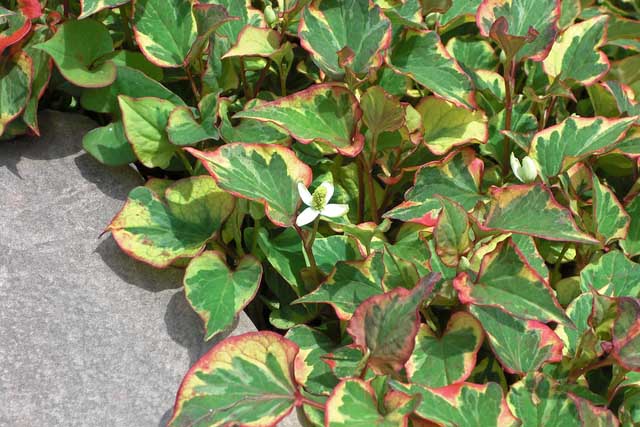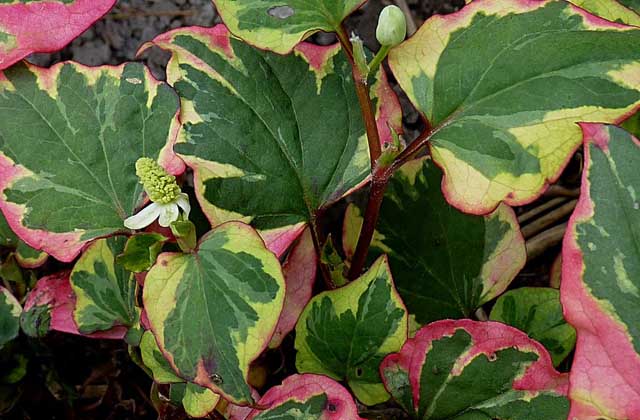In Western cultures, “leafy greens” are usually bitter or slightly citrusy-tasting greens like spinach, kale or arugula. By contrast, Asian cultures eat many more types of greens, including ones like Houttuynia Cordata – aka fish mint — which has a very distinct flavor (to say the least!). While the taste of fish mint might not be for everyone, it is loaded with health benefits that make it worth consuming.
What is Houttuynia Cordata?

Houttuynia Cordata is a really gorgeous plant with heart-shaped green leaves. The leaves often develop red and yellow splotches. Its pretty colors is what got Houttuynia Cordata it’s nicknames like chameleon plant and rainbow plant. It is indigenous to North-East India and China and used in Asian medicine and recipes.
Other Names
- Fish mint
- Fish wort
- Fish leaf
- Heart leaf
- Rainbow plant
- Chameleon plant
- Chinese lizard tail
- Diếp Cá (Vietnamese)
Health Benefits of Houttuynia Cordata

Houttuynia Cordata has long been used as a natural remedy and has numerous benefits, including fighting viruses, bacteria, inflammation, diabetes, and more. The plant is the subject of numerous research papers which back up these benefits.
Anti-Viral
Houttuynia Cordata is probably best known as a natural treatment for the SARS virus. This study, for example, found that Houttuynia Cordata inhibited anti-SARS effects. Other studies have also found that Houttuynia Cordata fights viruses, including herpes simplex types 1 and 2, influenza, and even HIV.
Anti-Bacterial
In addition to being a potent anti-viral, Houttuynia Cordata can also fight off bacteria. Studies found that extracts of the plant reduced salmonella bacteria.
Anti-Inflammatory
Houttuynia Cordata is an ancient Chinese remedy for inflammation. Today, there are numerous studies which back up Houttuynia Cordata’s anti-inflammatory benefits. Its mechanism of action is similar to non-steroidal anti-inflammatory drugs. Considering how many diseases are linked to inflammation, Houttuynia Cordata could help numerous health conditions.
Allergies
Because Houttuynia Cordata can calm down cytokines which cause immune overreactions, it can help treat allergies naturally.
Diabetes
When eaten raw, fish mint can help lower blood sugar levels. It also fights diabetes by improving insulin resistance and glucose tolerance, as well as improving levels of the healthy HDL cholesterol.
One study found it only took 8 weeks of treatment to improve insulin resistance in rats. Unfortunately, there are few human studies backing Houttuynia Cordata for diabetes.
Balance Gut Health (Microbiome)
Houttuynia Cordata may have a positive effect in balancing gut health. A study found that it controlled gram-negative bacteria in the gut, including E. coli. Today we know that gut health, specifically the microbiome, is linked to wide-ranging aspects of health. An unbalanced gut (dysbiosis) is linked to depression, anxiety, obesity, SIBO and IBS, autism, and much more.
Healing Skin
Houttunynia Cordata extract is a common ingredient in high-end face creams and lotions and is especially popular in Japan. Houttuynia Cordata’s used as a skin treatment goes back centuries. The leaves are made into a poultice which helps heal skin, likely because of its anti-bacterial and anti-inflammatory properties.
Lung Health
In traditional Chinese medicine, Hottuynia Cordata is often used to treat lung infections. The anti-viral and anti-inflammation benefits also help with lung infections. However, Hottuynia cordata also helps because it regulates mucus and can could help regulate the gut-lung axis.
Obesity
One of the most-mentioned benefits of Hottuynia cordata is weight loss. There is actually very little evidence to back this up, though one study did find that the plant reduced fat intake in mice. In any case, drinking Hottuynia cordata tea or eating it as salad is certainly healthier than junk food options. 36]
How to Use Fish Mint
Houttuynia Cordata has a unique fish-like taste and aroma to it. A lot of people really hate the taste of it and can’t get over how “weird” it is. However, when paired with the right foods, fish mint can actually be quite tasty.
Because fish mint has such as distinct, strong taste, it is best paired with other strong foods. Usually it is eaten with grilled meat. It also often goes into stews or soups.
A few traditional fish mint recipes are:
- Gỏi Cuốn (Vietnam): Gỏi Cuốn means “spring rolls”. Instead of rice papers, sometimes fish mint is used as the wrapper.
- Bánh xèo (Vietnam): bánh xèo are a type of Vietnamese stuffed crepe. Fish mint is sometimes used as a garnish or fill.
- Zhé’ěrgēn (China): In China, fish mint root is called Zhé’ěrgēn and used as a spice.
If you want to eat raw fish mint in a salad, I’d suggest putting some lemon juice on it. The lemon really helps balance out the fishy taste.
Houttuynia Cordata Tea
Dried fish mint leaves can be made into a tea for medicinal benefits. Because of the fishy taste, it is almost a bit like drinking soup. I personally preferred iced fish mint tea with honey and lemon in it to balance out the flavors.
Instructions:
- Boil two cups of water.
- Remove from heat.
- Add 1 tablespoon of dry, chopped fish mint leaves to the water.
- Let the tea steep for at least 3 minutes. For medicinal benefits, steep longer.
- Strain and serve with honey and/or lemon.
Where to Buy Fish Mint

It’s actually pretty easy to grow fish mint at home in most parts of the USA. Some people even use it as a ground cover. Note that fish mint does spread like crazy, so don’t plant it in your yard unless you are fine with having lots of it.
If you don’t grow you own fish mint, you sometimes can find it in Vietnamese grocers. You can also buy fish mint on Amazon. Here are some of the best brands.
Fish Mint Tea/Dried Houttuynia Cordata Leaves
Medicinal Dried Houttuynia Leaves
Eidolon Green Medicinal Houttuynia
Houttuynia Powder
Yuo Xing Cao Houttuynia Cordata Powder
Houttuynia Cordata Tincture
Skin Products with Houttuynia Cordata
Organic Houttuynia Face Mask
Goodal Houttuynia Cordata Moisturizer
Daymellow Houttuynia Cordata Soothing Gel
Dr.G SPF50 Face Sunscreen with Houttuynia Cordata
Image credits:
“2009.06.12_14.35.10_CIMG1068” (CC BY 2.0) by AndreyZharkikh
Houttuynia_cordata_Chameleon, by Jamain, Creative Commons Attribution-Share Alike 3.0 Unported, 2.5 Generic, 2.0 Generic and 1.0 Generic license.
“Houttuynia cordata ’Chameleon’” (CC BY-NC-ND 2.0) by Brande Jackson
https://www.ncbi.nlm.nih.gov/pmc/articles/PMC3931198/
https://www.thieme-connect.com/products/ejournals/abstract/10.1055/s-2006-958063
https://www.sciencedirect.com/science/article/pii/S2211383517306421
https://www.worldscientific.com/doi/abs/10.1142/S0192415X03001090
https://www.sciencedirect.com/science/article/abs/pii/S0378874105006227
https://www.spandidos-publications.com/mmr/8/3/731?text=fulltext
https://www.sciencedirect.com/science/article/abs/pii/S037887411733670X
https://www.tandfonline.com/doi/full/10.1080/09168451.2016.1151339
https://www.sciencedirect.com/science/article/abs/pii/S0378874108000408
https://www.frontiersin.org/articles/10.3389/fendo.2018.00620/full
https://arnoldzwicky.org/2018/05/31/a-plant-too-invasive-even-for-me/









Ceai Houttuynia Cordata
Please tell me if it is possible to make tea from fresh leaves and flowers (green)
Eugen Safta
Theoretically, yes, you can make tea from fresh leaves. It just isn’t nearly as potent. If you want to use fresh leaves, it’s best to chopp them up finely first to release some of the juices.